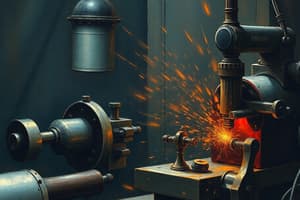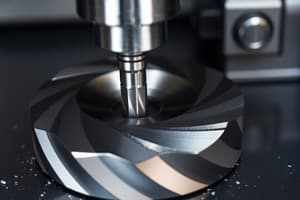Podcast
Questions and Answers
What is the primary purpose of machining in manufacturing?
What is the primary purpose of machining in manufacturing?
- To remove unwanted material from workpieces (correct)
- To alter the properties of materials
- To assemble final products
- To create raw materials
Which of the following describes the role of primary motion in machining?
Which of the following describes the role of primary motion in machining?
- It generates a lateral movement of the workpiece.
- It provides the necessary feed rate to advance the cutting tool. (correct)
- It allows for the removal of material through grinding processes.
- It helps in cooling the cutting edge during operations.
What is the secondary motion in a machining process?
What is the secondary motion in a machining process?
- The feeding motion of the workpiece. (correct)
- The removal of chips from the cutting area.
- The cooling and lubrication procedures during machining.
- The rotational movement of the cutting tool.
Which cutting tool is not traditionally associated with hand tools?
Which cutting tool is not traditionally associated with hand tools?
In the context of machining, what does the term 'cutting speed' refer to?
In the context of machining, what does the term 'cutting speed' refer to?
What is the primary motion in machining?
What is the primary motion in machining?
How does the power consumption compare between primary motion and secondary motion in machining?
How does the power consumption compare between primary motion and secondary motion in machining?
What is the significance of the secondary or feed motion in machining?
What is the significance of the secondary or feed motion in machining?
What is the formula for calculating cutting speed (v) for turning operations?
What is the formula for calculating cutting speed (v) for turning operations?
In machining, what does the term 'cutting speed' refer to?
In machining, what does the term 'cutting speed' refer to?
Which of the following is NOT a characteristic of primary motion in machining?
Which of the following is NOT a characteristic of primary motion in machining?
What role does the diameter of the cutting tool play in calculating cutting speed?
What role does the diameter of the cutting tool play in calculating cutting speed?
For which machining processes is cutting speed a crucial parameter?
For which machining processes is cutting speed a crucial parameter?
What does the total time consumed for one full (double) stroke depend on?
What does the total time consumed for one full (double) stroke depend on?
What is represented by the variable N in the context of machining operations?
What is represented by the variable N in the context of machining operations?
In milling operations, what does the feed rate U represent?
In milling operations, what does the feed rate U represent?
What is the purpose of the clearance angle in cutting tools?
What is the purpose of the clearance angle in cutting tools?
The rake angle of a cutting tool is important for which of the following?
The rake angle of a cutting tool is important for which of the following?
To calculate the feed rate for turning and drilling, what formula is used?
To calculate the feed rate for turning and drilling, what formula is used?
Which factor does NOT influence the total time consumed for a double stroke?
Which factor does NOT influence the total time consumed for a double stroke?
If the cutting speed is represented as 'v', which unit should it typically be expressed in?
If the cutting speed is represented as 'v', which unit should it typically be expressed in?
What does 'sz' refer to in the context of milling?
What does 'sz' refer to in the context of milling?
In machining, the length of a stroke is typically measured in which units?
In machining, the length of a stroke is typically measured in which units?
What does '𝑙' represent in the formula related to shaping cutting speed?
What does '𝑙' represent in the formula related to shaping cutting speed?
What is the relationship between the rapid return speed '𝑣𝑟' and the cutting speed '𝑣'?
What is the relationship between the rapid return speed '𝑣𝑟' and the cutting speed '𝑣'?
In the shaping operation, what does the formula 𝑡𝑐 = 𝐿/𝑣 calculate?
In the shaping operation, what does the formula 𝑡𝑐 = 𝐿/𝑣 calculate?
What condition must always be true for the variable '𝑘' in shaping operations?
What condition must always be true for the variable '𝑘' in shaping operations?
Which of the following components is NOT directly involved in the formula for shaping cutting speed?
Which of the following components is NOT directly involved in the formula for shaping cutting speed?
What is the primary motion utilized during the shaping operation?
What is the primary motion utilized during the shaping operation?
Why is it advantageous for the rapid return speed to be higher than the cutting speed?
Why is it advantageous for the rapid return speed to be higher than the cutting speed?
Which term describes the speed at which the cutting tool returns without cutting?
Which term describes the speed at which the cutting tool returns without cutting?
What factor does NOT affect the time consumed in the cutting stroke during shaping?
What factor does NOT affect the time consumed in the cutting stroke during shaping?
In the shaping process, which parameter is crucial for determining efficiency?
In the shaping process, which parameter is crucial for determining efficiency?
Flashcards
Primary Motion
Primary Motion
The main movement of a machine tool or manual operation that brings the cutting tool close to the workpiece. It's responsible for initiating the machining process.
Secondary or Feed Motion
Secondary or Feed Motion
The secondary movement of a machine tool, usually relative to the workpiece, which removes material in a continuous, repeated motion, resulting in a machined surface with a specific shape.
Cutting Speed (v)
Cutting Speed (v)
The speed at which the cutting tool moves relative to the workpiece in the direction of the cut, expressed in meters per minute (m/min). It's often represented by 'v'.
Cutting Speed Formula
Cutting Speed Formula
Signup and view all the flashcards
Depth of Cut
Depth of Cut
Signup and view all the flashcards
Feed Rate
Feed Rate
Signup and view all the flashcards
Cutting Edge
Cutting Edge
Signup and view all the flashcards
Cutting Edge Geometry
Cutting Edge Geometry
Signup and view all the flashcards
Total time consumed for one full stroke
Total time consumed for one full stroke
Signup and view all the flashcards
Number of full strokes per minute
Number of full strokes per minute
Signup and view all the flashcards
Feed (s)
Feed (s)
Signup and view all the flashcards
Feed per tooth (sz)
Feed per tooth (sz)
Signup and view all the flashcards
Feed rate (U)
Feed rate (U)
Signup and view all the flashcards
Rake Angle
Rake Angle
Signup and view all the flashcards
Clearance Angle
Clearance Angle
Signup and view all the flashcards
Depth of cut (a)
Depth of cut (a)
Signup and view all the flashcards
Machining
Machining
Signup and view all the flashcards
Cutting Tool
Cutting Tool
Signup and view all the flashcards
Time consumed by cutting stroke (tc)
Time consumed by cutting stroke (tc)
Signup and view all the flashcards
Time consumed by return stroke (tr)
Time consumed by return stroke (tr)
Signup and view all the flashcards
Return stroke time ratio (k)
Return stroke time ratio (k)
Signup and view all the flashcards
Rapid return speed (vr)
Rapid return speed (vr)
Signup and view all the flashcards
Shaping Cutting Speed Formula
Shaping Cutting Speed Formula
Signup and view all the flashcards
Stroke length (L)
Stroke length (L)
Signup and view all the flashcards
Reciprocation speed (N)
Reciprocation speed (N)
Signup and view all the flashcards
Cutting time (tc) and Return time (tr)
Cutting time (tc) and Return time (tr)
Signup and view all the flashcards
Idle time
Idle time
Signup and view all the flashcards
Manufacturing
Manufacturing
Signup and view all the flashcards
Secondary Motion (Feed)
Secondary Motion (Feed)
Signup and view all the flashcards
Chip
Chip
Signup and view all the flashcards
Study Notes
Manufacturing Technology 1 (MEC 112) - Basic Concepts
- Manufacturing is the industrial process of changing raw materials into finished products.
- Manufacturing technology encompasses all methods for shaping raw materials into final products, including forming, casting, welding, and machining.
- Machining is the process of removing unwanted material from a workpiece to achieve the desired size, shape, and surface quality.
- Nontraditional machining techniques are alternative methods for machining complex shapes in hard, strong, and tough materials that are challenging for traditional methods.
Machining
- Machining uses a cutting tool to remove metal.
- Hand tools (chisels, files, hacksaw blades) use muscular effort for metal removal, making them slow and expensive.
- Machine tools are power-operated devices designed to produce a specified surface by removing metal.
- The principle of all machine tools involves generating the required surface by controlling the relative motion between the cutting tool and the workpiece.
Generating Motions of Machine Tools
- Machine tools use relative motions between the cutting tool and workpiece to create surfaces.
- The removed material is called a chip.
- Flat and cylindrical surfaces are the simplest to generate using either primary or secondary motions on a machine tool.
Primary and Secondary Motions
- The primary motion is the main motion of a machine tool, causing relative movement between the tool and the workpiece.
- The secondary motion, or feed motion, combined with the primary motion creates a repeated or continuous movement that results in a finished machined surface with specific geometric properties.
- The primary motion normally uses a significantly higher proportion of the machine's power compared to the feed motion.
Cutting Speed (v) Variables
- Cutting speed (v) is the relative speed between the tool and the workpiece in the direction of the cut.
- For turning, drilling, and milling, cutting speed is calculated as: v = (πDN)/1000, where D is the workpiece diameter, N is the spindle rotational speed.
- For shaping, cutting speed is calculated as: v = (LN(1+k))/1000, where L is stroke length, N is reciprocation speed, k is a constant less than 1 (related to time for return stroke)
Feed (s)
- Feed is the feed travel per revolution of the workpiece (turning and drilling), or for shaping it is the feed per stroke (mm/stroke).
- In milling, feed is expressed as 'feed per tooth' (mm/tooth)
- Feed rate (U) = s N (mm/min) for turning and drilling; and U = s₂ z N (mm/min) for milling, where s is the feed per revolution, N is the rotational speed, and z is the number of cutter teeth.
Cutting Tools and Tool Geometry
- Cutting tools must have appropriate angles like rake angle and clearance angle for efficient metal removal.
- The rake angle facilitates chip formation.
- The clearance angle minimizes friction between the tool and the workpiece.
- Cutting tools are made of materials harder than the workpiece material to resist wear from friction, the most common examples being: plain carbon tool steels, alloy tool steels, high-speed steels, cemented carbides, ceramics, and diamonds. To withstand the wear and tear on the flank faces and rake faces.
Studying That Suits You
Use AI to generate personalized quizzes and flashcards to suit your learning preferences.




